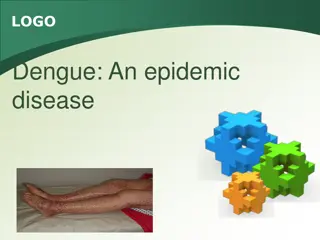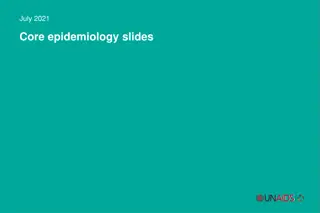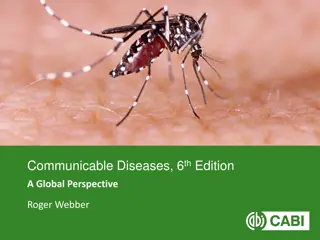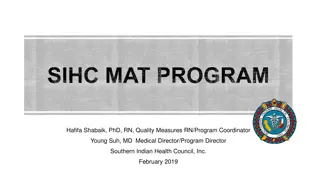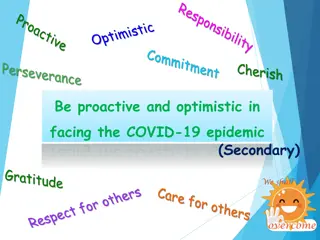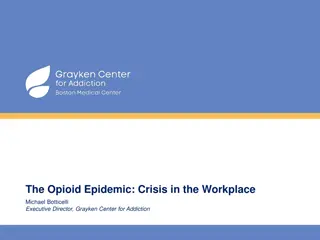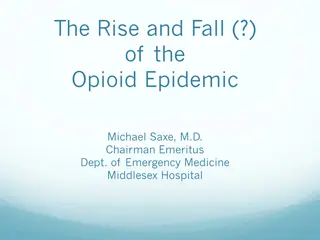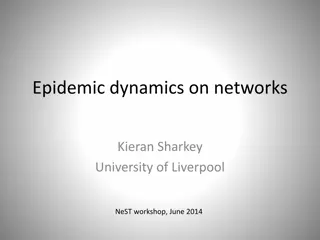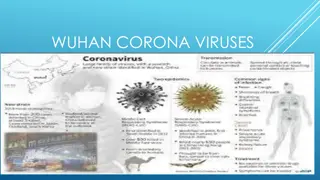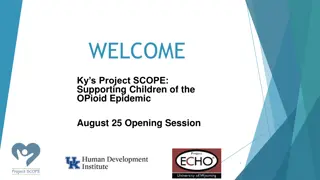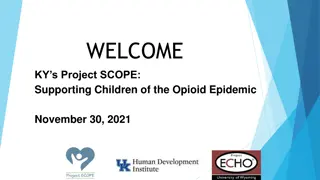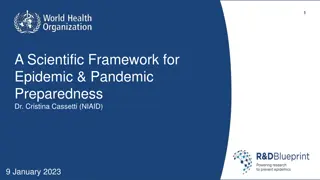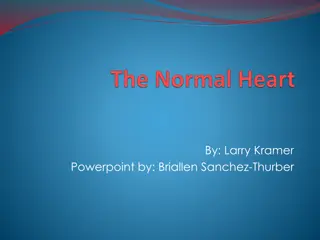Learning Chemistry Through Epidemic Prevention
Explore the use of bleach in epidemic prevention through engaging learning activities that involve understanding bleach concentrations, chemical reactions, and safety measures. Students will gain knowledge on using bleach effectively, converting concentrations, and investigating chemical properties, fostering a positive attitude towards safe chemical handling and informed decision-making.
Download Presentation

Please find below an Image/Link to download the presentation.
The content on the website is provided AS IS for your information and personal use only. It may not be sold, licensed, or shared on other websites without obtaining consent from the author.If you encounter any issues during the download, it is possible that the publisher has removed the file from their server.
You are allowed to download the files provided on this website for personal or commercial use, subject to the condition that they are used lawfully. All files are the property of their respective owners.
The content on the website is provided AS IS for your information and personal use only. It may not be sold, licensed, or shared on other websites without obtaining consent from the author.
E N D
Presentation Transcript
CHEMISTRY LEARNING ACTIVITY IN RELATION TO EPIDEMIC PREVENTION
INTRODUCTION In prevention of spreading bacteria and virus, bleach is often the best choice among the household disinfectants. The recent development of epidemic offers an appropriate occasion for the Chemistry students to explore and learn the chemical knowledge and skills in relation to bleach. Learning through daily life related examples and experience will facilitate students to be aware of the relationship of chemistry and society. In addition, students will be encouraged to apply their chemical knowledge as well as the thinking and skills of scientific investigation in making informed judgements and decisions in daily life. This resource includes two learning activities: Activity 1 Using bleach wisely Activity 2 Experimental investigative activities in relation to bleach
LEARNING OBJECTIVES After completing these learning activities, students should be able to: describe the active ingredient of household bleach convert the unit of concentration in a solution from weight percentage to molarity perform calculation on concentrations in relation to dilution of bleach understand the potential hazards of bleach investigate the active ingredient of bleach by conducting titrimetric analysis develop a positive attitude towards the safe handling, storage and disposal of household chemicals make informed decisions and judgements on chemistry-related issues based on scientific methodology and critical thinking
ACTIVITY 1 USING BLEACH WISELY Content of the learning activity: 1. Ask students to read one of the following articles: 10 (Chinese version only) https://www.consumer.org.hk/ws_chi/news/specials/2020/bleach-usage.html The Use of Bleach https://www.chp.gov.hk/files/pdf/the_use_of_bleach.pdf 2. After reading the article, ask students to answer/discuss the following questions: (a) Write the chemical formula of the active ingredient of bleach (i.e. sodium hypochlorite), and the chemical formula of its anion and cation. (b) Sodium hypochlorite in bleach will decompose gradually with time to form sodium chloride and oxygen. (i) Write the chemical equation for the decomposition of sodium hypochlorite; (ii) Explain if the above decomposition reaction is a redox reaction or not. (c) Assuming that the concentration of sodium hypochlorite in bleach by weight percentage (w/v) is 5.25%, convert this concentration to mol dm-3. [relative atomic masses: Na = 23.0, Cl = 35.5, O = 16.0]
(d) After diluting a bleach of 5.25% sodium hypochlorite with water in the ratio of 1:99, what is the concentration of sodium hypochlorite in the diluted bleach solution? (e) Based on the recommendation of the Department of Health, 1:99 diluted household bleach (mixing 10 mL of 5.25% bleach with 1 L of water) can be used for general household cleaning and disinfection. If the household bleach you bought has the concentration lower than 5.25%, is it sufficient to use 10 mL of this bleach for the dilution? Why? (f) Toxic gas (chlorine gas / Cl2(g)) may be produced when bleach is mixed with acidic detergents such as those used for toilet cleaning. The related chemical reaction is shown below: 2H+(aq) + OCl-(aq) + Cl-(aq) Based on the above reversible reaction, explain why the pH value of bleach should be maintained at 11 or above. Cl2(g) + H2O(l)
(g) On the internet, it is claimed that adding vinegar into bleach can greatly enhance its effectiveness of disinfection. It is because hypochlorous acid (HOCl(aq)) has a much higher disinfection power than sodium hypochlorite. Do you believe it? Please state your justifications. (h) Why should we avoid over-stocking bleach at home? (i) State the potential hazards in using bleach and the corresponding safety precautions. The suggested answers are available in the following link: https://docs.google.com/document/d/1g2c0nN- OOcyJCzLW2kBbyPS0MI_zWwNTUCnlagMsgek/edit?usp=sharing
SUGGESTION FOR LEARNING AND TEACHING (ACTIVITY 1) The activity involves a number of topics Topic II Microscopic World I Topic III Metals Topic IV Acids and bases Topic VII Redox reactions, chemical cells and electrolysis Topic X Chemical equilibrium Teachers may adapt the discussion questions according to learning progress and prior chemical knowledge of students in different levels. Teachers may consider to conduct this activity in the form of online learning. For example, Google Forms or other online platforms / instant communication software can be used to disseminate the related information and questions to students and to collect their answers. For the answers involving calculations, students may submit those by means of photos which captured the solution steps and answers written on a paper. Teachers (or students) can also produce and disseminate videos for demonstrating how to balance chemical equations or calculate the molarity of diluted bleach, etc., in order to foster exchange and discussion between teachers and students.
ACTIVITY 2 EXPERIMENTAL INVESTIGATIVE ACTIVITIES IN RELATION TO BLEACH After completing Activity 1, teachers could provide more information relating to this topic and assign students to design some related experiments at home. This will prepare for conducting experimental investigative activities later when classes resume. The following resources could be provided to students as guidance for designing experimental investigations: (1) Online resources on chemistry experimental techniques Volumetric Analysis (i) Preparation of a Standard Solution (ii) Titration [http://minisite.proj.hkedcity.net/chemtech/eng/volumetric_analysis/index.html] (2) Textbook references on titrimetric analysis of bleach samples (Topic XV Analytical Chemistry)
INVESTIGATIVE ACTIVITY (A) HYPOCHLORITE CONTENT OF BLEACH SAMPLES An extract from the passage released by Consumer Council https://www.consumer.org.hk/ws_en/news/press/20090715-5.html Household bleaches with concentration of active ingredient (sodium hypochlorite) less than 5.25% are not recommended to be used on a dilution ratio of 1:99 as an effective disinfectant In a test on 29 models of household bleach, the Consumer Council has found that many of the samples were not up to 5.25% in concentration. Student activities: With reference to the information of the bleach product samples provided by teacher, design and conduct a titration experiment to find the hypochlorite content of the bleach samples.
INVESTIGATIVE ACTIVITY (B) HOW FAST DOES CHLORINE BLEACH DETERIORATE? An extract from the passage released by Consumer Council https://www.consumer.org.hk/ws_en/news/press/20090715-5.html Consumers are advised also not to purchase household bleaches in excessive quantity as sodium hypochlorite is unstable and will decompose over time. Precautions in use of household bleach as disinfectant: Diluted solution should be used as soon as possible, and best within 24 hours to achieve effective disinfection. Student activities: Design and conduct experiments to illustrate the decrease in concentration of sodium hypochlorite in bleach over time. Guiding questions: 1. What method could be used to monitor the change in concentration of the active ingredient in chlorine bleach over time? 2. Will different external factors (e.g. sunlight, temperature) affect the change in hypochlorite concentration in bleach?
SUGGESTION FOR LEARNING AND TEACHING (ACTIVITY 2) The activity involves a number of topics: Topic IV Acids and bases Topic VII Redox reactions, chemical cells and electrolysis Topic XV Analytical chemistry Teachers may select and adapt the scope and the related experimental activities of the investigations according to learning progress and prior chemical knowledge of students in different levels. This practical activity involves the concept and skills in redox titration. For students who are not familiar with this chemical knowledge, teachers are advised to elaborate about the relevant chemical reactions and principles before conducting the investigative activity with students.


